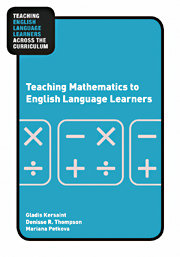Keith Kelly reviews this new book from Routledge aimed at CLIL teachers teaching mathematics through the medium of English and recommends it as a 'must-read'.
 |
English Language Learners in the US
There is a well-known and well-documented growth in learners in the US state education system coming from migrant families. One welcome recent result of this phenomenon is that there are more publications like this one aimed at helping and informing the work of the teachers whose job it is to work with these learners in the US curriculum.
I’d recommend this book firstly to anyone teaching Maths through the medium of English as a foreign or second language and secondly to all teachers teaching their subjects through the medium of English interested in a glimpse of how one subject area is going about it.
A few shortcomings
The only shortcomings I could find with the book - and I’m starting with this because there are so many positive things to say that it makes sense to get it out of the way - is that there are many references to the specific culture of the learning environment found in US classrooms. Readers in contexts outside the USA may not find the two sections of the book dedicated to this area as relevant as the others.
Many positive things
Now that’s out of the way, let me describe what you get:
- A general discussion of the process of English language learning and the implications this has for classroom practice.
- A look into the pedagogical aspects of teaching one curriculum to learners from diverse cultural backgrounds.
- An overview of the influences English language learning can have on the attainment of Maths learners working through English as a foreign language.
- A clear discussion of what is the language Mathematics, and the particular difficulties this can have for foreign and second language learners and with a stress on the teacher knowing what language is expected of learners in any given task.
- Recommendations for improving classroom practice when working with English language learners. 'Effective mathematics teaching requires understanding what students know and need to learn and then challenging and supporting them to learn it well' (p.43). Sounds like common sense, but it needs to be said!
- A description of maths classrooms which support English language learners and an outline of the things teachers can do to ‘orchestrate’ classroom language to further maths concept and language development. In addition, strategies are offered for helping learners understand maths language.
There is also a whole section dedicated to problem solving, putting a stress on this area of maths and supporting language needed to be able to do this maths.
Of course, there is also a reference to assessment, with clear and simple principles for guiding teachers assessing second language learners in maths.
Extras!
A real bonus in this book is the detailed and comprehensive list of other literature, other links to follow up. Not least is the reference to the Texas State University System: Mathematics for English Language Learners Project (www.tsusmell.org) which has, among other things, a very readable and meaningful case study: Understanding English Through Mathematics: A Research Based ELL Approach to Teaching All Students. Here, the researchers follow one teacher’s highly successful attempts at turning mathematics tuition around to become teaching maths through the English language (the stress on through English is mine) with the outcome that the mathematics results of the students involved outperform comparative groups following traditional methods.
This book really was a satisfying and useful read, and a book I return to again and again for a number of reasons, not least for specific hints on areas of language difficulty and what to do about them for second language maths students, am also working my through the follow-up reading and links and finding more treasures for CLIL.
In short – a must have book for CLIL Maths teachers, and a useful read for CLIL teachers in general!

No comments yet